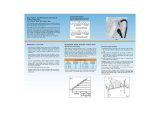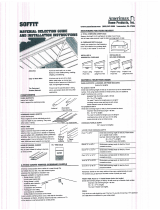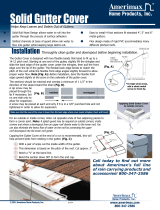Amerimax Home Material Installation guide
- Type
- Installation guide

J-channel (Decorative)
Frieze Moulding
12" wide Panels
Fascia 4",
6", 8", 10"
heights
available
1" Fascia
Runner
* Note – When product is installed in Florida see
Approval # FL 5896 for installation instructions with specifi c
adherence to the 2004 Florida Building Code.
http://www.fl oridabuilding.org/pr/pr_detl.asp?IPT=5896&RV=0&fm=ROSrch
MATERIAL SELECTION GUIDE
AND INSTALLATION INSTRUCTIONS
Attractive: Aluminum won’t split, rot, or warp.
Baked on fi nish resists peeling, cracking,
chipping, and blistering.
Easy To Work With: Aluminum can be cut with a sharp blade,
metal snips, or circular saw. Fasten it with a
hammer and (aluminum) nails. It’s lightweight
but strong.
The Permanent Proven over the past 50 years in siding, storm,
Outdoor Material: and screen doors and many other applications.
COMPONENTS
PANEL SUPPORTS
(twelve foot lengths)
Used to support the overhang panels.
OVERHANG PANELS (SOFFIT)
(twelve foot lengths)
These lengths are cut into individual
panels to match the depth of your overhang.
They come either solid or vented.
FRONT TRIM
(twelve foot lengths)
Used to cover the wood trim to which your gutter is
attached. Now is a good time to decide on replacing
your old gutters with an AMERIMAX RAIN CARRYING
SYSTEM. The front trim may be slipped under the
existing gutter if it is not removed. If front trim is not
used, additional panel supports are required.
DOUBLE CHANNEL RUNNER
(twelve foot lengths)
May be used instead of butting
J channels at mitred corners.
1
1
/
4
" TRIM
NAILS
A WORD ABOUT VENTED OVERHANG PANELS
Amerimax vented panels allow outside air to pass through the roof rafters into your
attic. Your attic exhaust system completes this important air circulation loop. Adequate
ventilation is required to prevent:
• Energy losses in summer
from a super-heated attic
• Energy losses in winter
caused by attic insulation
that has soaked up
condensation and moisture.
• Peeling paint and rotting wood
caused by condensation buildup inside the framework of the house.
A solid wooden overhang allows none of this vital air circulation.
For adequate ventilation, Amerimax recommends that a minimum of
1
/
3
of the aluminum overhang panels be vented panels.
MEASURING FOR YOUR PROJECT
A. TOTAL OVERHANG LENGTH (feet)
Measure the length (L) of overhang on all sides of your house. Add all these
measurements to get the total overhang length, in feet.
B. OVERHANG DEPTH (inches)
Identify your project from the illustrations
below and measure the overhang depth,
in inches, to the nearest 1/8 of an inch.
INSTALLING A
HORIZONTAL OVERHANG
INSTALLING AN
INCLINED OVERHANG
Overhang
Depth
Overhang
Depth
Overhang
Depth
Overhang
Depth
Project I using
Front Trim
Project II not
using Front Trim
Project III using
Front Trim
Project IV not
using Front Trim
MATERIAL SELECTION GUIDE
PANEL SUPPORTS: J-CHANNEL OR FRIEZE MOULDING (twelve foot lengths)
For projects I and III
Divide total overhang length (in feet) by 12 and round up to the nearest whole number.
If not using double channel at mitred corners, add one additional length if overhang
turns a corner.
Example: Total Overhang Length = 80 feet
80 ÷ 12 = 6
8
/
12
lengths
You need 7 twelve foot lengths plus one length if overhang turns a corner
and you are not using a double channel runner at mitred corner.
For projects II and IV
Divide total overhang length ( in feet) by 6 and proceed as above.
Example: Total Overhang Length = 80 feet
80 ÷ 6 = 13
2
/
6
lengths
You need 14 twelve foot lengths plus one length if overhang turns a corner
and you are not using double channel runner at mitred corner.
OVERHANG PANELS: SOFFIT (12" x twelve foot lengths)
LOCATE YOUR OVERHANG DEPTH
From 7" to 8
1
/
8
" Divide total overhang length (in feet) by 18 and round up
to nearest whole number.
Example: total overhang length = 80 feet
80 ÷ 18 = 4
8
/
18
lengths
You need 5 twelve foot lengths.
Over 8 ½" to 9 ¾" Divide total overhang length (in feet) by 15 and proceed as above.
Over 9 ¾" to 12
1
/
8
" Divide total overhang length (in feet) by 12 and proceed as above.
Over 12
1
/
8
" to 16
1
/
8
" Divide total overhang length (in feet) by 9 and proceed as above.
Over 16
1
/
8
" to 24
1
/
8
" Divide total overhang length (in feet) by 6 and proceed as above.
Over 24
1
/
8
" to 48
1
/
8
" Divide total overhang length (in feet) by 3 and proceed as above.
Remember: Decide on how many solid and how many vented panels you want. The
answers you get above are the total number of panels you need.
FRONT TRIM: Fascia or 1" Fascia Runner (twelve foot lengths)
Divide total overhang length (in feet) by 12 and round up to nearest whole number.
Example: total overhang length = 80 feet
80 ÷ 12 = 6
8
/
12
lengths
You need 7 twelve foot lengths.
NAILS:
Only aluminum nails should be used. One box (¼ pound) of Amerimax 1¼" aluminum trim
nails should be suffi cient for your entire project.
www.amerimax.com
(800) 347-2586
Lancaster, PA 17604
Circular saw
with fi ne
tooth blade
for cutting
metal
Measuring tape
Carpenter’s square
Sharp knife
Metal snips
Chalkline
Level
Hammer
TOOLS
REQUIRED
CAUTION:
When nailing aluminum, hammer only until nail head touches
aluminum surface. Further hammering may prevent normal
expansion and cause buckling.
Before You Begin
Remove an existing trim. Consider possible obstructions such as utility lines. Panels may
be cut to fi t around them or contact your utility company for removal or replacement.
Remove Any
Existing Trim
L1 L 2

STEP 1. INSTALL PANEL SUPPORTS
(J-CHANNEL or FRIEZE MOULDING)
• Always start at one end of the house.
• No overlap is needed where lengths meet.
• Nail on approximate 16" centers.
FOR PROJECTS I AND III, WHERE NEW OVERHANG WILL BE ON
THE SAME ANGLE AS EXISTING OVERHANG OR RAFTERS
Install along wall of house by nailing through long leg into existing wooden
overhang or rafters.
STEP 3: INSTALL FRONT TRIM
(Fascia or 1" Fascia Runner)
Note: If you are removing your existing gutter, mark the locations of the rafters so you can
remount your gutter by fastening into the rafters, which is preferred over fastening to the
wooden front trim.
When turning a corner
Wrap-around should be about 2". Cut out the
bottom lip with metal snips and blend front trim
as shown. The fi rst piece used after turning the
corner should overlap and come completely
to the corner. Starting at one end, place front
trim with bottom lip snug against the overhang
panels. The top edge may be slipped under box
style guttering it if it has not been removed. Nail
as shown on approximate 16" centers. Do not
overdrive nails. When installing the next length,
overlap the fi rst by ½" to 1" and nail through
the overlap joint.
ROOF GABLE BOARDS
Amerimax Fascia can also be used to cover
Gable Boards. Follow, the same procedure as
above, mitre cutting the panels at the peak.
CLEANING INSTRUCTIONS
Aluminum can be cleaned by using a mild
soap and water solution. You should never use
abrasive cleaners or pads.
Project II
Fig. A
Project I
Fig. C
Fig. B
A
A
FOR PROJECT I, WHERE YOU ARE CHANGING FROM AN
INCLINED OVERHANG TO A HORIZONTAL OVERHANG
Mark point on wall level with bottom edge of wooden front trim
at both corners (A). Strike a chalkline between the two points.
Make 1” wide nailing fl anges on long edge of panel
supports by notching with metal snips and bending
up. Fasten panel supports to wall with long side
up and top horizontal edge even with
chalkline, nailing through fl anges.
FOR PROJECTS II AND IV
WHERE NEW OVERHANG WILL
BE ON THE SAME ANGLE AS
EXISTING OVERHANG RAFTERS
Install along inside of wooden front trim
by nailing through long leg or into existing
overhang or rafters.
Fig. D
Project IVProject III
At one end of house, install only one length along the wall by nailing through long leg into
existing wooden overhang or rafters (see Fig. A). Successive lengths will be installed along
the wall after the overhang panels have been installed into the previous lengths.
FOR PROJECT II, WHERE YOU ARE CHANGING FROM
AN INCLINED OVERHANG TO A HORIZONTAL OVERHANG
Install along inside of wooden front trim (see Fig. D). Follow procedure illustrated in Fig. B
to strike a chalkline on wall. Chalkline should be level with bottom leg of panel support. At
one end of house, install only one length along the wall by forming 1” wide nailing fl anges
and nailing to wall with bottom horizontal edge even with chalkline. Successive lengths will
be installed along the wall after the overhang panels have been installed into the previous
lengths.
STEP 2. INSTALL OVERHANG PANELS (Soffit)
FOR ALL PROJECTS:
Subtract ¼ inch (for clearance)
from your measured overhang
depth. Using this new
dimension, cut the twelve foot
lengths into individual panels,
using your circular saw with
fi ne tooth metal cutting blade.
Always start at one end of
the house. The fi rst panel
must be installed with
interlocking-nailing edge square with the wall and positioned to receive the next panel.
FOR PROJECTS I AND III
Insert each panel into support and
approximately even with outside edge of
wooden front trim. Install each successive
panel, pushing it up against the previous panel
until it interlocks, before nailing into the bottom
of the wooden front trim.
FOR PROJECTS II AND IV
Install the panel by sliding it into the tracked
formed by the two panel supports. Install
each successive panel, pushing it against the
previous panel until it interlocks. Proceed until
panel support against wall is fi lled. Install one
additional length of panel support against the
wall, as before. Proceed with installation of
panels and panel supports.
Going Around Corners
If inside or outside corners are involved, make
a mitre joint by butting two J-channels back
to back as shown, or use Double Channel
Runner. Cut the soffi t panels at the proper
angle to fi t.
Important: Decide on the solid vs. vented pattern you wish to use. If you are covering an
existing overhang you should cut a hole in the old overhang (to the approximate panel
size) at each vented panel in order to achieve the desired air circulation.
Panel Support
Square
Overhang
Panel
Interlocking
Nailing
Edge
2"
Bend
90
2"
www.amerimax.com
(800) 347-2586
Lancaster, PA 17604
-
 1
1
-
 2
2
Amerimax Home Material Installation guide
- Type
- Installation guide
Ask a question and I''ll find the answer in the document
Finding information in a document is now easier with AI
Related papers
Other documents
-
Amerimax Home Products 7710159 Operating instructions
-
Amerimax Home Products L3250 Installation guide
-
Gibraltar Building Products ADC-WH Installation guide
-
Gibraltar Building Products ADC-WH Installation guide
-
Amerimax Home Products 85280BX Operating instructions
-
Amerimax Home Products 86200BX Installation guide
-
 Frost King RC160 Installation guide
Frost King RC160 Installation guide
-
Gibraltar Building Products 4PVS16-WH Operating instructions
-
Gibraltar Building Products FH6-CR-WH Operating instructions
-
Gibraltar Building Products RFR-HG Operating instructions





